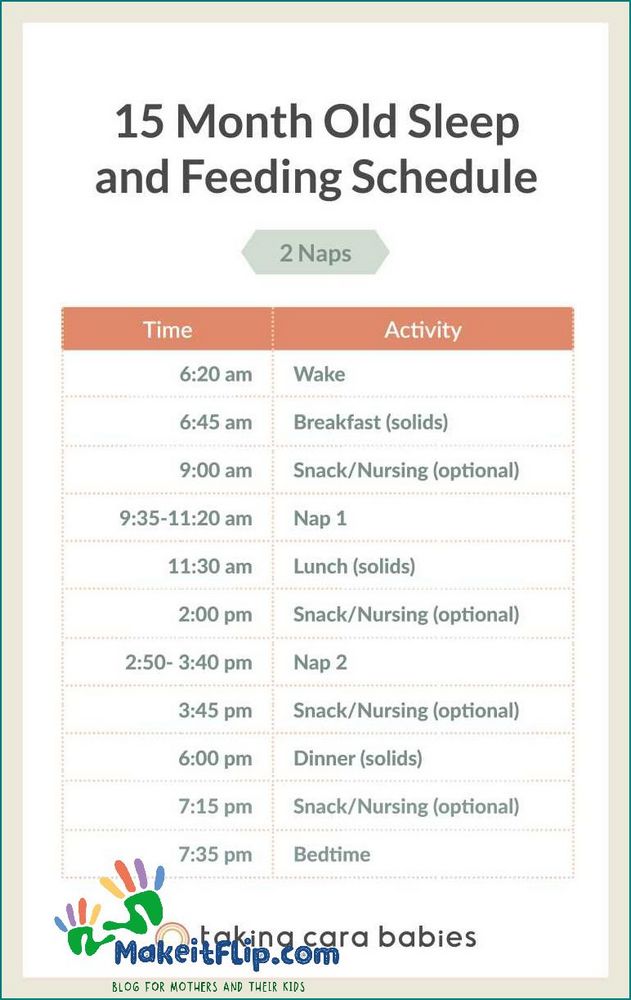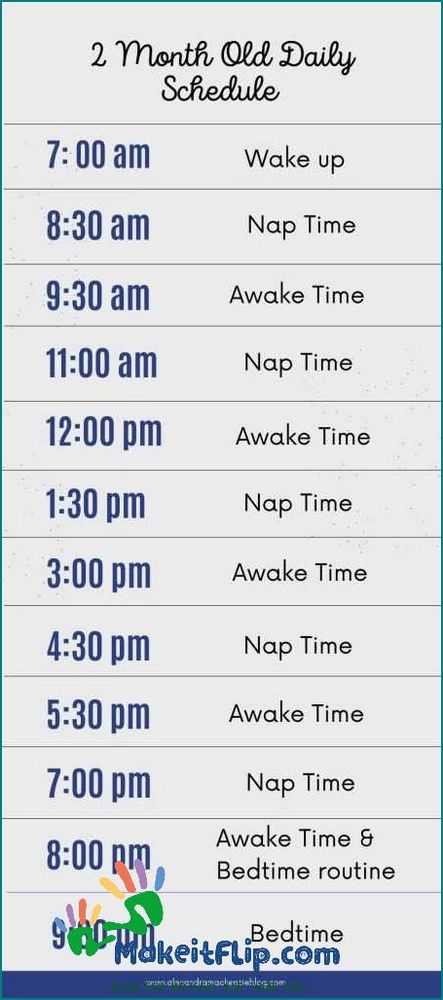Contents
- 1 Daily Routine and Sleep Patterns for a 2-Month-Old: Establishing a Healthy Schedule
- 1.1 Establishing a Daily Routine for Your 2 Month Old
- 1.2 FAQ about topic 2 Month Old Schedule Daily Routine and Sleep Patterns
- 1.2.1 What should be the daily routine for a 2-month-old baby?
- 1.2.2 How many naps should a 2-month-old baby take during the day?
- 1.2.3 What are the signs that a 2-month-old baby is ready for sleep?
- 1.2.4 How can I help my 2-month-old baby establish a sleep routine?
- 1.2.5 What should I do if my 2-month-old baby is not sleeping well?
- 1.2.6 How many naps should a 2-month-old baby take during the day?
- 1.2.7 What is a good bedtime for a 2-month-old baby?
Daily Routine and Sleep Patterns for a 2-Month-Old: Establishing a Healthy Schedule

At 2 months old, babies are starting to develop a more predictable schedule and sleep patterns. While every baby is different, establishing a routine can help provide structure and promote healthy sleep habits.
Sleep: Most 2-month-old babies sleep for around 14 to 17 hours a day, with naps lasting anywhere from 30 minutes to 2 hours. It’s important to create a calm and soothing environment for your baby’s sleep, such as using a white noise machine or swaddling them.
Feeding: By this age, most babies are still feeding every 2 to 3 hours, whether breastfed or formula-fed. It’s important to pay attention to your baby’s hunger cues and feed them on demand. If you’re breastfeeding, make sure to burp your baby after each feeding to prevent discomfort.
Playtime: While sleep and feeding are important, playtime is also crucial for your baby’s development. At 2 months old, babies are starting to become more alert and engaged with their surroundings. You can engage them with toys, tummy time, and gentle interactions.
Bedtime Routine: Establishing a bedtime routine can help signal to your baby that it’s time to wind down and prepare for sleep. This can include activities such as a warm bath, a gentle massage, reading a book, or singing a lullaby. Consistency is key, so try to follow the same routine every night.
Remember, every baby is different, and it’s important to be flexible and adjust the schedule based on your baby’s individual needs. Consulting with your pediatrician can also provide guidance and support as you navigate your baby’s daily routine and sleep patterns.
Establishing a Daily Routine for Your 2 Month Old
At 2 months old, your baby is starting to become more aware of their surroundings and may be ready for a more structured daily routine. Establishing a schedule can help provide a sense of security and predictability for both you and your baby. Here are some tips for creating a daily routine for your 2 month old:
- Set consistent wake-up and bedtime routines: Try to wake your baby up at the same time each morning and establish a soothing bedtime routine to help them wind down and prepare for sleep.
- Establish regular feeding times: Aim to feed your baby at consistent intervals throughout the day, such as every 2-3 hours. This can help regulate their hunger cues and promote healthy eating habits.
- Incorporate playtime and tummy time: Schedule regular periods of playtime and tummy time throughout the day to help your baby develop their motor skills and engage with their environment.
- Create a nap schedule: Pay attention to your baby’s sleep cues and establish a nap schedule that works for both of you. This can help prevent overtiredness and promote better sleep.
- Be flexible: While it’s important to have a routine, it’s also important to be flexible and adapt to your baby’s needs. Some days may require more or less sleep, feeding, or playtime, and that’s okay.
Remember that every baby is different, and what works for one may not work for another. It may take some trial and error to find the right routine for your 2 month old, so be patient and observant. As your baby continues to grow and develop, their routine may need to be adjusted accordingly.
Feeding Schedule

When your baby is 2 months old, it is important to establish a feeding schedule to ensure they are getting the nutrition they need. At this age, your baby will still be primarily consuming breast milk or formula.
Typically, a 2-month-old baby will need to be fed every 2-3 hours, or about 8-12 times a day. It is important to watch for hunger cues, such as rooting or sucking on their hands, to know when your baby is ready to eat.
During each feeding, it is important to make sure your baby is getting enough milk. They should be nursing for about 10-15 minutes on each breast, or consuming about 2-3 ounces of formula. If your baby is still hungry after a feeding, you can offer them more milk.
It is also important to burp your baby after each feeding to help prevent gas and discomfort. Gently pat or rub their back until they burp.
As your baby grows, their feeding schedule may change. It is important to follow their cues and adjust their schedule accordingly. Consulting with your pediatrician can also help ensure your baby is getting the right amount of nutrition at each stage of their development.
Playtime and Developmental Activities

At 2 months old, your baby is starting to become more alert and interested in the world around them. Playtime is not only fun, but it also plays a crucial role in their development. Here are some activities you can incorporate into your baby’s schedule to promote their growth and learning:
1. Tummy Time: Place your baby on their tummy for short periods throughout the day. This helps strengthen their neck and back muscles, which are essential for later milestones like crawling and sitting up.
2. Sensory Play: Introduce your baby to different textures, sounds, and colors. You can use toys with different textures or make simple sensory bins using items like rice or fabric. This helps stimulate their senses and encourages exploration.
3. Music and Singing: Sing songs or play soft music for your baby. This can help soothe them and also expose them to different sounds and rhythms, which can aid in their auditory development.
4. Reading: Start reading simple board books to your baby. Even though they may not understand the words yet, it helps develop their language skills and introduces them to the concept of books.
5. Baby Gym: Invest in a baby gym or create one using a play mat and hanging toys. This allows your baby to practice reaching and grabbing objects, which helps improve their hand-eye coordination.
Remember, playtime should be enjoyable and interactive for both you and your baby. Follow their cues and let them explore at their own pace. As they grow, you can introduce new activities to keep them engaged and promote their development.
Naptime and Bedtime

At 2 months old, establishing a schedule for naptime and bedtime can help your baby develop healthy sleep patterns. While every baby is different, here is a sample schedule that you can follow:
- 7:00 am – Wake up
- 8:30 am – First nap
- 10:00 am – Wake up and play
- 12:00 pm – Second nap
- 2:00 pm – Wake up and play
- 4:00 pm – Third nap
- 5:30 pm – Wake up and play
- 7:30 pm – Bedtime routine (bath, feeding, story time)
- 8:00 pm – Bedtime
It’s important to note that this schedule is just a guideline and may need to be adjusted to fit your baby’s needs. Pay attention to your baby’s sleep cues and adjust the schedule accordingly. Creating a consistent and soothing bedtime routine can also help signal to your baby that it’s time to sleep.
During naptime and bedtime, create a calm and quiet environment to help your baby relax and fall asleep. Dim the lights, use white noise or soft music, and make sure the room is at a comfortable temperature.
Remember, every baby is different, and it may take some time to find the right schedule and routine that works for your little one. Be patient and flexible as you navigate your baby’s sleep patterns.
FAQ about topic 2 Month Old Schedule Daily Routine and Sleep Patterns
What should be the daily routine for a 2-month-old baby?
A 2-month-old baby’s daily routine should include regular feeding, napping, and playtime. It is important to establish a consistent schedule to help the baby feel secure and develop healthy sleep patterns.
How many naps should a 2-month-old baby take during the day?
A 2-month-old baby typically takes 3-4 naps during the day, each lasting around 1-2 hours. It is important to watch for signs of tiredness and put the baby down for a nap when they show these signs.
What are the signs that a 2-month-old baby is ready for sleep?
Signs that a 2-month-old baby is ready for sleep include rubbing their eyes, yawning, becoming fussy or irritable, and losing interest in toys or activities. It is important to respond to these cues and create a calm and soothing sleep environment for the baby.
How can I help my 2-month-old baby establish a sleep routine?
To help your 2-month-old baby establish a sleep routine, you can create a consistent bedtime routine that includes activities such as a warm bath, gentle massage, and reading a bedtime story. It is also important to create a calm and dark sleep environment and avoid overstimulation before bedtime.
What should I do if my 2-month-old baby is not sleeping well?
If your 2-month-old baby is not sleeping well, it is important to first ensure that their basic needs are met, such as being fed and having a clean diaper. You can also try creating a soothing bedtime routine, using white noise or a pacifier, and ensuring that the sleep environment is comfortable and safe. If sleep issues persist, it may be helpful to consult with a pediatrician for further guidance.
How many naps should a 2-month-old baby take during the day?
A 2-month-old baby should take around 4-5 naps during the day.
What is a good bedtime for a 2-month-old baby?
A good bedtime for a 2-month-old baby is usually around 7-8 PM.
I’m Diana Ricciardi, the author behind Makeitflip.com. My blog is a dedicated space for mothers and their kids, where I share valuable insights, tips, and information to make parenting a bit easier and more enjoyable.
From finding the best booster seat high chair for your child, understanding the connection between sciatica and hip pain, to exploring the benefits of pooping in relieving acid reflux, I cover a range of topics that are essential for every parent.
My goal is to provide you with practical advice and solutions that you can easily incorporate into your daily life, ensuring that you and your child have the best possible experience during these precious years.
